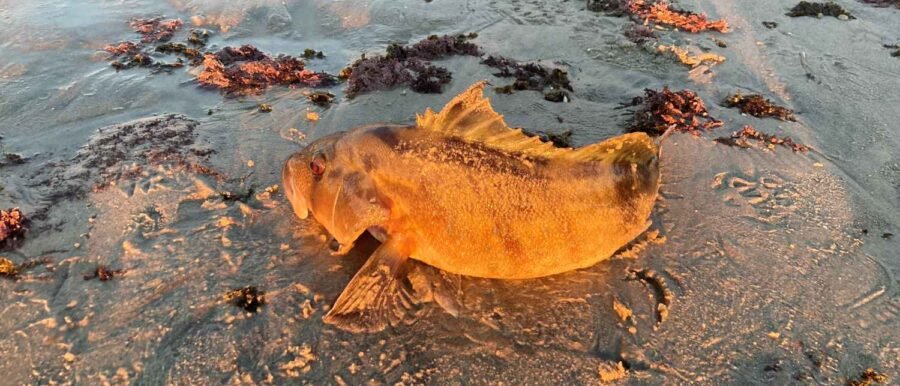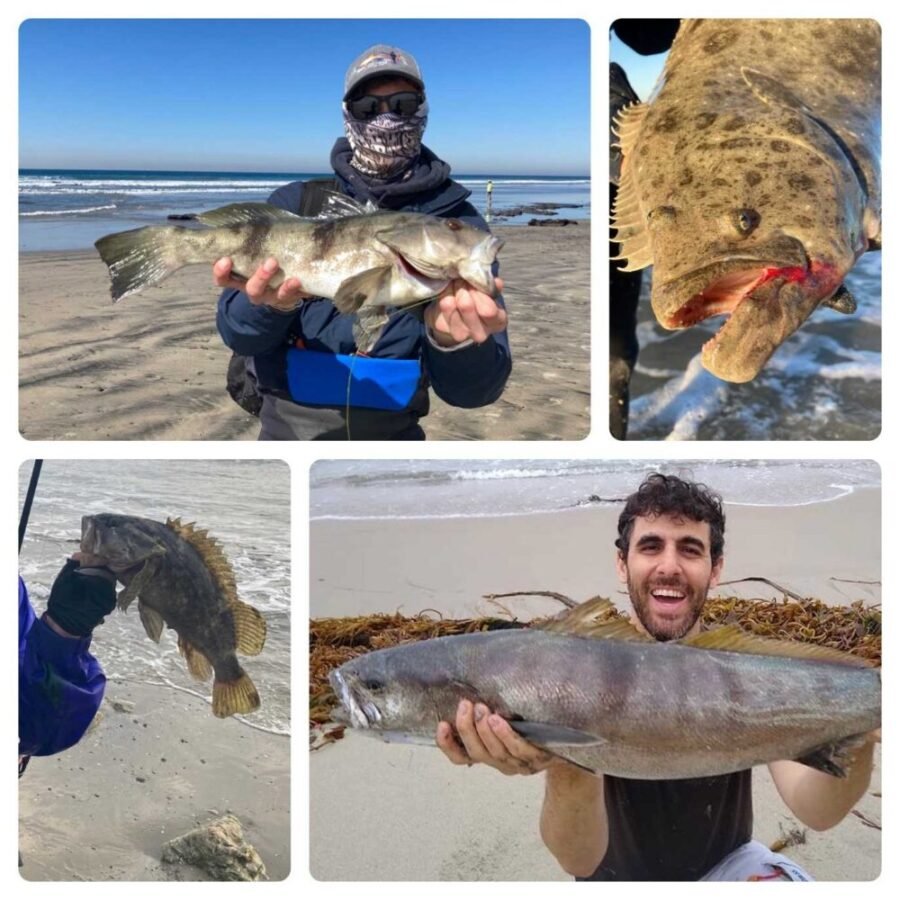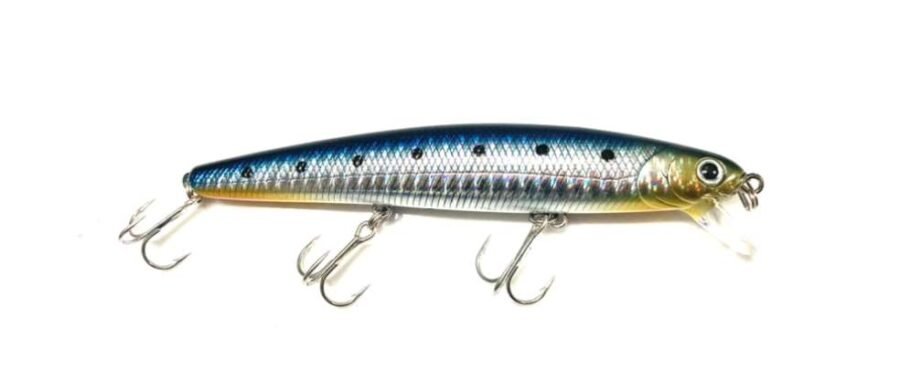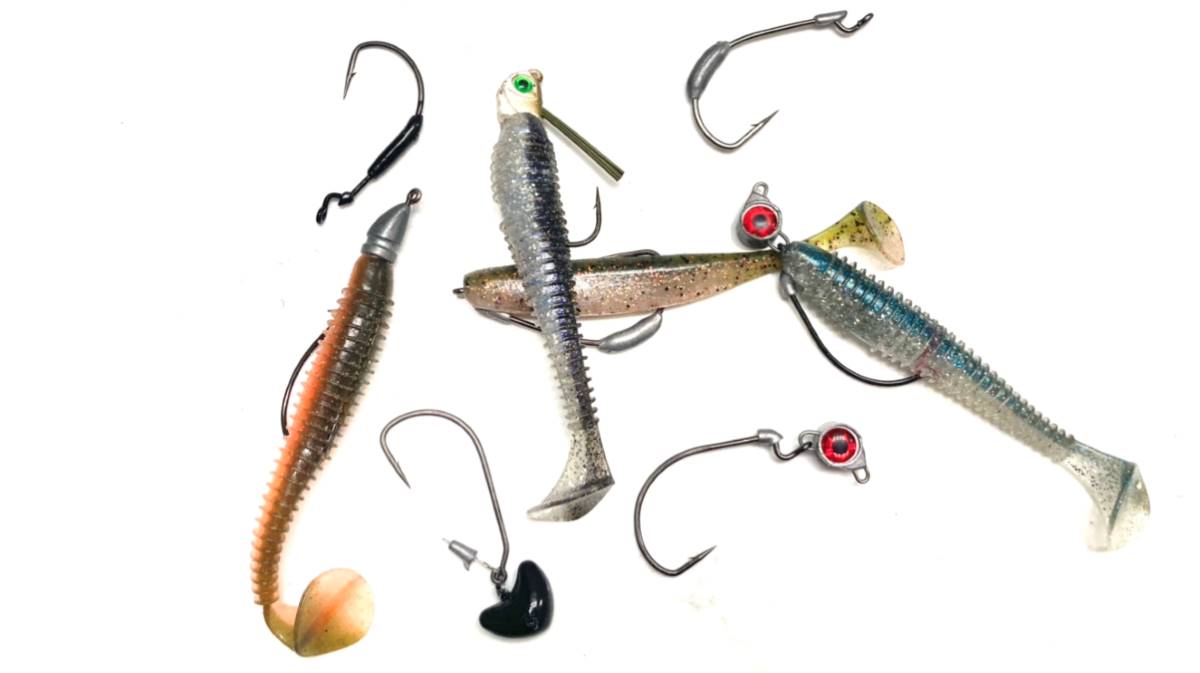Surf Fishing with Swimbaits: How to and Video

Swimbaits are one of the most common types of lures out there. If you’re background is in bass fishing, you’ve likely spent many hours throwing swimbaits and many dollars buying them. But can you use swimbaits in the surf? Absolutely, you can! Let’s talk about surf fishing with swimbaits and how to use swimbaits at the beach.
In a recent article, we talked about the difference between jerkbaits and swimbaits and when you might use each. Today, we’ll be diving deep on swimbaits… no pun intended. Here’s an overview of the article:
- What is a swimbait lure?
- When to use a swimbait lure
- How do you fish a swimbait?
- What types of fish do swimbaits catch?
- Best rods and reels for swimbaits
- Best swimbait lures for surf fishing
Surf Fishing with Swimbaits Video
I’ve been spending a lot of time learning as much as I can about surf fishing with swimbaits and this last year has been a very memorable one for me. Below, you’ll find my first video on fishing at the beach with swimbaits. Be sure to like, share, and subscribe if you like the content.
What is a Swimbait Lure?
A swimbait lure is technically any lure that imitates the natural swimming motion of a baitfish. These can be soft plastic and hard plastic (or even wood). Soft plastic paddle-tails or curly-tails are typically what come to mind but jointed hard plastics are techically swimbaits as well.
This article will be a how-to guide on soft-plastic swimbaits.
When to Use a Swimbait Lure
When surf fishing with lures, I typically approach it with two main choices: swimbaits or jerkbaits. In a recent article, we did a deep dive on jerkbaits vs swimbaits and when to use which in terms of conditions, location etc.
Generally speaking, the main advantage to using swimbaits in the surf is that you can fish them weedless. What does “weedless” mean with respect to swimbaits and other lures?

Weedless typically implies that your lure either has some sort of guard to keep weeds from accumulating or snagging on your hook or the hook is hidden in the lure and placed in a way that when a fish bites the lure, the hook pops out and does its job.
The image above shows a Keitech swimbait that was rigged weedless by utilizing a Warbaits jighead hook with a weed guard. The image below shows a Z-Man swimbait that was rigged weedless by utilizing an Owner sledhead hook with the point of the hook hidden inside the soft body of the lure.

Why Weedless Matters
If I’m not using a weedless swimbait, I’m typically using a jerkbait and we all know how snaggy jerkbaits can be. It’s one of the major pros and major cons of using jerkbiats. They catch everything… including seaweed and rocks and the barnacles etc. attached to rocks.
So, in conditions that are a little too weedy or dirty in terms of the water, weedless swimbaits have a huge advantage over other lures. Additionally, in environments that are filled with rocks, reefs or vegetation, weedless swimbaits will hold the action they were designed to hold while other lures won’t fare so well.
How to Fish Swimbaits
Like any lure, there are a handful of tactics that are deemed “best practice”. Anglers typically wonder the following:
- Let the Lure Fall or Not
- Speed of Retrieve
- Twitches or No Twitches
- Hook Set or Not
Before we dive in, one important piece of advice that I’ve become a huge believer in is this. Before you start fishing a new lure, take it into the shallow water, and run it back and forth. Give it some twicthes, let it fall, rise, and try all different types of retrieves and speeds. Get a feel for what you think looks most attractive to a fish and when you start fishing it, envision your lure and twicth it or retreive it like you can see what it’s doing in your mind.
Confidence is key and when you’re confident your lure looks enticing to your target, it’s only a matter of time before you hook up.
Let it Fall
In my experience, I prefer to let the lure fall atleast a little bit before beginning my retrieve. As you let the lure fall, it should already be doing its job as the tail begins to “swim”. Often, you’ll get hit on this first descent.
Speed of Retreive and Twitches
I’ve always preferred a slower retrieve than most anglers. I’ll let it fall, sometimes all the way to the bottom, give it an upward twitch and let it fall again. Sometimes I give the twitches a break and just do a slow, steady retrieve.
It depends on the water movement too though. For me, it really comes down to what I’m envisioning the lure is looking like as I retrieve it. Sometimes I twitch a ton, other times I don’t.
Hook Set
Learning a proper hook set when surf fishing with swimbaits was tough for me because most of my lure fishing experience was with jerkbaits. With jerkbaits I simply don’t set the hook. All those trebles take care of the hook set for me and with the hard body of a jerkbait, a hook set can often leverage one hook right out of the fish’s mouth resulting in a lost fish.
Surf fishing with swimbaits, it’s the opposite. The hook set needs to be timed right and it needs to be strong enough to drive the hook into the fish’s lip. It’s extremely tough to get the timing right when you’re bouncing your lure off all sorts of rock and reef, especially when a hali hits and sits. Just a few weeks ago, I lost what I belive to be the biggest halibut of my life because I wasn’t sure whether I was stuck on a rock or a halibut… After about 5 seconds of standstill, it took off and that was that.
What Kinds of Fish Do Swimbaits Catch?

Swimbaits will catch the same species of fish that most other lures will catch, but swimbaits allow you to fish environments that hold some bigger larger model fish like white seabass, rockfish, calico and sandbass as well as halibut. I’ve learned surfperch will even take if their mouths are big enough for the lure.
Rod and Reel for Surf Fishing with Swimbaits and Other Lures
- Rod: Okuma SST-S-902HA – 1/2-2oz | 10-30lb | 9ft | H | MF
- Reel: Penn Spinfisher VI (3500 or 4500)
- Main Line: 30-pound braid
- Leader Line: 30-pound mono
- Lure Options:
- Lucky Craft FM 110 (jerkbait)
- Keitech Fat Swing Impact (4.8″) | Warbaits 0.5-ounce Weedless Jighead
- BioSpawn ExoSwim (4.75″) | Mustad KVD Grip Pin Swimbait Hook (5/0 | 1/8oz) (T Rigged)




hello, can you tell me what model keitech swim bait 2.8/3.0/4 inch? and what weight jig head
It’s a 4.8 inch keitech and a 0.5 oz jighead
Great write up Nick, I’m a Sledhead/Z-man fan. You’re correct, for me it’s hard to make to swap from the LC to swimbaits. I miss the first few because I don’t set the hook…………
I did exactly that just yesterday! It’s tough.
How do you tell whether it is fish and a missed hook set? 🙂
Hey John, the best answer/advice I can give you on this is to get out there and experience it. You get a feel after a few sessions for what a fish feels like in comparison to rocks, reefs etc.and you end up naturally knowing what your lure hits. Even to the point that you’ll be able to detect the different species by their bite and fight.
Good info & video Nick.
Ahhh! Thanks, Bill. Good to see you on the site and best of luck in the final week!
I love the way you cast in that video. Elegant and efficient.
Too kind, too kind. Thank you!
Nick that 30 lb Spiderwire braid you linked to at Amazon is moss green. Is there a reason its not some other color or translucent?
I personally don’t believe fish are bothered by the color of braid. Additionally, I’ve started using 3 feet of 50lb mono leader tied via a swivel. That’s been working very well and no decrease in bites.
Hi Nick, WOW! Interesting! you’re using a 3 feet of 50lb mono leader tied via a swivel to your main line 30lb braid . That’s been working very well and no decrease in bites. Nice!!
I will try the same technique to tie heavier leader line. I always worried breaking my first guide with a swivel while accidentally reeling the line too far..
I always tie double uni to my main 20lb fl. to 20lb braid or fish straight braid sometimes with a clip. I believe Calico, WSB or halibut strike down based on reaction and doesnt care much about the line visibility. Thanks for super nice articles!
Thanks! I’ve actually started just going 30lb braid to 30lb fluoro
Where is the location that you are fishing?
Im in SD county for the most part.